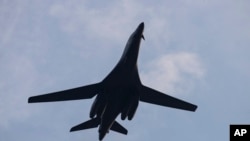The U.S. Air Force chief of staff is warning that the U.S. military must "change" if it wants to stay ahead of China and Russia.
“Our adversaries have continued to advance their capabilities at the same time we’ve been using some of the same capabilities we’ve been using for the past 30 years,” Gen. C.Q. Brown Jr. told VOA in an exclusive interview this week.
“The threat we were up against is not the threat we'll see in the future," he said. "And that's why we've got to, we've got to change."
One Air Force change will be front and center next month, when the United States unveils its new B-21 stealth bomber on December 2. The B-21 is set to replace the Air Force’s B-1 and B-2 bombers, which have been around since the 1980s.
Due to classification concerns, Brown did not provide the availability rates for the Air Force’s aircraft, which give leaders a clearer picture of what aircraft would be at their disposal in the event of a crisis.
“One thing I will say is that this is why I'm going to modernize, because we have some aircraft that are, from a maintenance standpoint, are a little harder, more difficult to maintain [with] diminishing resources for parts,” Brown said. “And that's the aspect of being able to modernize — so we increase the aircraft availability and ensure we have a ready force.”
Russia described as 'acute threat'
The Biden administration released its national defense strategy this year that labels Russia, which started a war in February after invading its neighbor Ukraine, an “acute threat.”
China is the United States’ “pacing challenge” and greatest threat to national security, according to the unclassified document released last month.
China has more active duty military personnel than the United States and spent decades advancing its weapons. In the last few years, the Chinese military has built new aircraft carriers, new fighter jets and a massive missile arsenal.
Melanie Sisson, a defense analyst with the Brookings Institution, says it’s “fair” to acknowledge the progress of potential adversaries like China, “but that fact alone shouldn't induce any panic in the United States.”
“We are still relatively very, very capable; the best military force in the world," she told VOA.
'I continue to see China sprinting'
China spent about $250 billion on its military in fiscal year 2022; the U.S. spent nearly eight times that amount.
Army veteran and defense analyst Bradley Bowman says overall military supremacy does not guarantee victory. He points out that China has “methodically and deliberately” chosen modernizations specifically designed to defeat the United States in East Asia, the most likely battlefield should war break out over Taiwan.
And that could make American ports and military bases in the region vulnerable to Chinese attacks.
“The Chinese have developed capabilities that are as good, in some cases better than ours,” Bowman told VOA. “America's military edge in the Pacific has absolutely eroded, and I continue to see China sprinting, while it often seems like we in Washington are slumbering.”
U.S. officials say China wants the ability to invade and hold Taiwan by 2027, and China has said it aims to be a world-class military capable of "fighting and winning wars" by 2049. China views Taiwan as a wayward province.
Brown said he’s seen Russian and Chinese efforts to expand their influence outside of the European and Indo-Pacific theaters, as well, including in the Middle East and Africa.
“I was there when the Russians came into Syria, and they're still there. You've also seen inroads of the PRC (People's Republic of China) with their base in Djibouti,” said Brown, who was the commander of U.S. Air Force’s Central Command from 2015-2016.
Maintaining strong relationships vital
As the United States’ military has shifted resources out of the Middle East to focus on China and Russia, Brown told VOA maintaining a strong relationship with allies in the region and leveraging growing U.S. capabilities, such as space-based systems, will be key.
He plans to visit allies Jordan, Qatar and the UAE later this month to meet with partners and spend time with U.S. airmen.
Last month, Brown visited partners in Ecuador, Peru and Colombia, where he discussed each country’s military modernization efforts.
In Colombia, he highlighted the U.S. delivery of additional C-130 transport aircraft.
Even in the Western Hemisphere, China and Russia seek to gain influence in places ranging from Venezuela, which has no formal ties with the U.S., to major non-NATO ally Argentina, where Buenos Aires is currently looking to spend hundreds of millions for new fighter jets.
Argentinian officials told lawmakers they are considering China and Pakistan’s JF-17, the United States’ F-16s, India’s Tejas, and the Russian-made MiG-35.
A retired senior military official told VOA Argentina wants American-made fighter jets, but any deal could face problems should Britain seek to block it. Britain, which makes some components of the F-16, has effectively maintained an arms embargo on Argentina since the 1982 Falklands War.
The official expressed concern that the British embargo could prompt Argentina to go to China for its defense needs.
Asked about this concern, Brown told VOA the U.S. “was going to pay attention to it.”
“My real focus is to ensure that we remain interoperable to the best of our abilities with our partners and have them understand that the United States and the United States Air Force is committed to working very closely with him,” he said.










